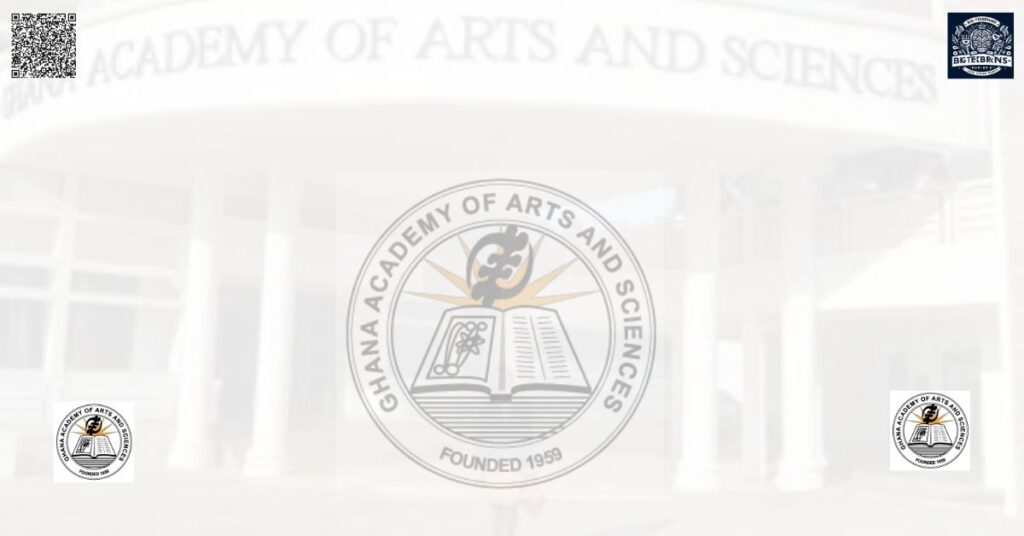Excerpt
The Ghana Academy of Arts and Sciences (GAAS) stands as a beacon of intellectual excellence, dedicated to the promotion and advancement of knowledge across all branches of the sciences and humanities. Established in 1959, GAAS has played a pivotal role in shaping Ghana’s academic and cultural landscape.
Historical Overview
Founded on the initiative of Ghana’s first president, Osagyefo Dr. Kwame Nkrumah, the Academy was initially known as the Ghana Academy of Learning. It was formally inaugurated in November 1959 by Prince Philip, Duke of Edinburgh, at the Great Hall of the University College of Ghana. In 1963, it merged with the National Research Council to become the Ghana Academy of Sciences. Following a governmental change in 1966, a reappraisal led to its division in 1968 into two entities:
- The Ghana Academy of Arts and Sciences, functioning as a purely learned society.
- The Council for Scientific and Industrial Research (CSIR), focusing on applied research related to national needs.
The addition of “Arts” to its name underscored its commitment to both the sciences and the humanities.
Constitutional Mandates
GAAS is mandated to:
- Promote the study, extension, and dissemination of knowledge in the arts and sciences.
- Establish and maintain proper standards of endeavor in all fields of the arts and sciences.
- Recognize outstanding contributions to the advancement of the arts and sciences in Ghana.
- Engage in activities conducive or incidental to achieving these objectives.
These mandates are fulfilled through lectures, symposia, public forums, workshops, and conferences, as well as awarding prizes for academic excellence.
Leadership and Structure
The Academy’s governance is vested in its Council, comprising:
- President
- Two Vice-Presidents (representing the Arts and Science sections)
- Honorary Secretary
- Honorary Treasurer
- Immediate Past President
- Five other elected fellows
The President oversees the Academy’s affairs, assisted by the Vice-Presidents. The Honorary Secretary manages administrative functions, while the Honorary Treasurer handles financial matters.
Offices and Units
GAAS operates through various offices and units that facilitate its mission, including:
- General Administration
- Finance
- Research Coordination
- Publications
- Public Relations
Mode of Appointment and Recruitment
Fellows of the Academy are elected based on significant contributions to their respective fields. The General Assembly of Fellows elects individuals who have demonstrated excellence in the arts or sciences. Additionally, the Council may elect honorary fellows of eminence who are not Ghanaian citizens but have made notable contributions to the advancement of the arts or sciences.
Affiliations and Partnerships
GAAS is officially represented on several national bodies, including:
- National Council for Tertiary Education
- Ghana National Commission on UNESCO
- Medical and Dental Council
- Science and Technology Research Endowment Fund (STREFund)
- Council for Scientific and Industrial Research (CSIR)
Internationally, the Academy is a member of organizations such as the Third World Academy of Sciences, International Academic Union, African Academy of Sciences, InterAcademy Panel, Network of African Science Academies (NASAC), and the International Council for Science (ICSU).
Operations and Activities
The Academy’s activities include:
Lectures and Symposia:
- Regular events featuring experts discussing various topics in the arts and sciences.
Public Forums and Workshops:
- Engagements aimed at disseminating knowledge and fostering public discourse.
Conferences:
- Gatherings that address critical issues pertinent to national development.
Publications:
- The Academy produces scholarly works and a bi-annual newsletter to share insights and research findings.
Historical Reforms
In 1966, after Dr. Nkrumah’s overthrow, the Academy underwent a thorough reappraisal. A committee chaired by Sir John Cockcroft recommended splitting the Academy into two entities:
- An Academy of Arts and Sciences operating as a strictly learned society.
- A Council for Scientific and Industrial Research concerned with applied research related to national needs.
This restructuring aimed to delineate the roles of pure academic pursuit and applied research to better serve national interests.
References
- https://gaas-gh.org/about/our-history/
- https://studylib.net/doc/8323977/ghana-academy-of-arts-and-sciences
- https://en.wikipedia.org/wiki/Ghana_Academy_of_Arts_and_Sciences
- https://newsghana.com.gh/advancing-knowledge-and-culture-the-ghana-academy-of-arts-and-sciences/
- https://www.modernghana.com/news/1270391/advancing-knowledge-and-culture-the-ghana-academ.html
- https://gaas-gh.org/wp-content/uploads/2023/05/MAY-2023-PRIN-ADM-ASS-GEN-ADM-SOW.pdf
- https://gaas-gh.org/
- https://gaas-gh.org/about/about-us/
- https://kasapafmonline.com/wp-content/uploads/2020/05/GAAS-Position-Paper-on-PUB-3-final.pdf

